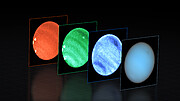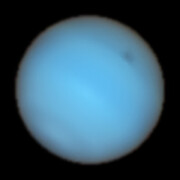Lehdistötiedote
Neptunuksen arvoituksellinen tumma pilkku on havaittu ensimmäistä kertaa maanpinnalta
24. elokuuta 2023, Turku
Tähtitieteilijät ovat havainneet suuren tumman pilkun Neptunuksen kaasukehässä ESO:n VLT-teleskooppia käyttäen (Very Large Telescope). Pilkun vieressä on odottamaton pienempi kirkas piste. Tämä on ensimmäinen kerta, kun planeetan tumma pilkku on havaittu maanpäällisellä teleskoopilla. Nämä aina välillä Neptunuksen ilmakehän sinisessä taustassa esiintyvät ilmiöt ovat mysteeri tähtitieteilijöille, ja uudet tulokset antavat lisää vihjeitä niiden luonteesta ja alkuperästä.
Irwin ja hänen tutkimusryhmänsä käyttivät ESO:n VLT-teleskoopilla otettua havaintoaineistoa sulkeakseen pois sen mahdollisuuden, että tummat pilkut johtuvat pilvien "selkenemisestä". Uudet havainnot osoittavat kuitenkin, että tummat pilkut johtuvat todennäköisesti ilmakehän hiukkasten tummumisesta enimmäkseen näkyvän usvakerroksen alapuolella olevassa kerroksessa, kun jäät ja usva sekoittuvat Neptunuksen kaasukehässä.
Tämän johtopäätöksen tekeminen ei ollut helppoa, koska tummat pilkut eivät ole Neptunuksen ilmakehässä pysyviä piirteitä eivätkä tähtitieteilijät olleet koskaan aikaisemmin kyenneet tutkimaan niitä riittävän yksityiskohtaisesti. Tähän tuli kuitenkin tilaisuus sen jälkeen, kun NASA/ESA:n Hubble-avaruusteleskooppi havaitsi Neptunuksen kaasukehässä useita tummia pilkkuja, joista yksi oli planeetan pohjoisella pallonpuoliskolla ja joka oli havaittu ensimmäisen kerran jo vuonna 2018. Irwin ja hänen tutkimusryhmänsä ryhtyivät heti tutkimaan sitä maasta käsin instrumentilla, joka sopii ihanteellisesti näihin haastaviin havaintoihin.
Tutkijat pystyivät VLT:n Multi Unit Spectroscopic Explorerin, eli MUSE:n avulla hajoittamaan Neptunuksesta heijastunutta auringonvaloa ja sen pilkun valon eri aallonpituuksiin ja saamaan kohteesta 3D-spektrin [1]. Tämä tarkoitti sitä, että he pystyivät tutkimaan pilkkua tarkemmin kuin aiemmin oli ollut mahdollista. "Olen aivan innoissani siitä, että olen pystynyt tekemään ensimmäisen havainnon tummasta pilkusta maasta käsin, sekä olen myös saanut otettua ensimmäistä kertaa tästä heijastusspektrin", Irwin sanoi.
Koska eri aallonpituuksilla havaitaan Neptunuksen kaasukehän eri syvyyksiä, spektrin avulla tähtitieteilijät pystyivät määrittämään paremmin tumman pilkun korkeuden planeetan kaasukehässä. Spektrin avulla saatiin myös tietoa ilmakehän eri kerrosten kemiallisesta koostumuksesta, mikä antoi ryhmälle vihjeitä siitä, miksi täplä näytti tummalta.
Havainnot tarjosivat myös yllätyksen. "Löysimme prosessin aikana harvinaisen syvän kirkkaan pilvityypin, jota ei oltu koskaan aiemmin tunnistettu edes avaruudesta käsin", kertoi Kalifornian yliopiston tutkija Michael Wong Berkeleystä, Yhdysvalloista. Tämä harvinainen pilvityyppi näkyi kirkkaana pisteenä aivan suuremman tumman pilkun vieressä. VLT:n data osoittaa, että uusi "syvä kirkas pilvi" oli ilmakehässä samalla tasolla kuin tumma pilkku. Tämä tarkoittaa, että se on täysin uudenlainen piirre verrattuna aiemmin havaittuihin pieniin korkealla sijaitseviin metaanijääpilviin.
Tähtitieteilijät pystyvät nyt ESO:n VLT:n avulla tutkimaan näiden pilkkujen kaltaisia kohteita Maasta käsin. "Tämä on hämmästyttävä lisä kyvyssämme havaita maailmankaikkeutta. Pystyimme aikaisemmin havaitsemaan nämä pilkut vain lähettämällä sinne luotaimia, kuten Voyagerin. Pystyimme sitten havaitsemaan niitä etänä Hubblella. Lopulta teknologian kehitys on tehnyt saman mahdolliseksi maanpinnalta käsin," totesi Wong, ennen kuin lisäsi leikillisesti: "Tämä voisi tehdä minut työttömäksi yhtenä Hubblen havaitsijoista!"
Lisähuomiot
[1] MUSE on 3D-spektrografi, jonka avulla tähtitieteilijät voivat havaita koko kohdetta samalla kertaa, kuten tässä Neptunusta. Mittalaite havaitsee kuvan jokaisessa pikselissä valon voimakkuutta värin tai aallonpituuden funktiona. Lopputuloksena on data, joka muodostaa 3D-kuvan, jossa kuvan jokaisessa pikselissä on mukana koko valon spektri. MUSE mittaa samanaikaisesti yli 3500:a väriä. Instrumentti on suunniteltu hyödyntämään adaptiivista optiikkaa, joka korjaa Maan ilmakehän turbulenssin vaikutuksia, jolloin saadaan terävämpiä kuvia kuin muuten olisi mahdollista. Ilman näitä ominaisuuksia Neptunuksen tumman pilkun tutkiminen Maasta käsin ei olisi ollut mahdollista.
Lisätietoa
Tämä tutkimus on esitelty artikkelissa nimeltään “Cloud structure of dark spots and storms in Neptune’s atmosphere”, joka julkaistaan Nature Astronomy (doi: 10.1038/s41550-023-02047-0) lehdessä.
Tutkimuksessa mukana ovat olleet seuraavat tahot: Patrick G. J. Irwin (University of Oxford, Yhdistynyt kuningaskunta [Oxford]), Jack Dobinson (Oxford), Arjuna James (Oxford), Michael H. Wong (University of California, Yhdysvallat [Berkeley]), Leigh N. Fletcher (University of Leicester, Yhdistynyt kuningaskunta [Leicester]), Michael T. Roman (Leicester), Nicholas A. Teanby (University of Bristol, Yhdistynyt kuningaskunta), Daniel Toledo (Instituto Nacional de Técnica Aeroespacial, Espanja), Glenn S. Orton (Jet Propulsion Laboratory, Yhdysvallat), Santiago Pérez-Hoyos (University of the Basque Country, Espanja [UPV/EHU]), Agustin Sánchez Lavega (UPV/EHU), Lawrence Sromovsky (University of Wisconsin, Yhdysvallat), Amy Simon (Solar System Exploration Division, NASA Goddard Space Flight Center, Yhdysvallat), Raúl Morales-Juberias (New Mexico Institute of Technology, Yhdysvallat), Imke de Pater (Berkeley), ja Statia L. Cook (Columbia University, Yhdysvallat).
Euroopan eteläinen observatorio (ESO) tekee maailmankaikkeuden salaisuuksien tutkimisen mahdolliseksi kaikille tutkijoille ympäri maailman. Suunnittelemme, rakennamme ja operoimme huippuluokan maanpäälisiä observatorioita, joita tähtitieteilijät käyttävät jännittävien tutkimusongelmien ratkaisemiseen ja populääritähtitieteen edistämiseen. Me edistämme myös kansainvälistä yhteistyötä tähtitieteen alalla. ESO perustettiin hallitustenväliseksi järjestöksi vuonna 1962 ja nykyään ESO:ssa on mukana 16 jäsenvaltiota (Itävalta, Belgia, Tšekki, Tanska, Ranska, Suomi, Saksa, Irlanti, Italia, Alankomaat, Puola, Portugali, Espanja, Ruotsi, Sveitsi ja Yhdistynyt kuningaskunta) yhdessä Chilen isäntävaltion kanssa ja Australian kanssa strategisena kumppanina. ESO:n pääkonttori ja sen vierailijakeskus ja planetaario, ESO Supernova, sijaitsevat lähellä Müncheniä Saksassa. Chilen Atacaman aavikko on upea paikka, jossa on ainutlaatuiset olosuhteet tähtitaivaan tarkkailuun. Se on kaukoputkiemme sijoituspaikka. ESO:lla on kolme havaintopaikkaa: La Silla, Paranal ja Chajnantor. Paranalissa ESO operoi Very Large Telescope (VLT) kaukoputkea ja siihen liittyvää Very Large Telescope Interferometria sekä paikalla sijaitsevia taivaankartoitusteleskooppeja: infrapuna-alueella toimivaa VISTAa ja näkyvän valon alueella toimivaa VLT Survey Teleskooppia. Paranalissa ESO isännöi ja operoi myös Cherenkov Telescope Array South havaintolaitetta, joka on maailman suurin ja herkin gamma-alueella havaitseva observatorio. ESO operoi yhdessä kansainvälisten kumppaneiden kanssa APEX- ja ALMA-observatriota Chajnantorilla, jotka ovat kaksi millimetri- ja alimillimetrin alueella toimivaa havaintolaitetta. Rakennamme parhaillaan Paranalin lähelle Cerro Armazonesille "maailman suurinta silmää taivaalle”, ESO:n Erittäin suurta kaukoputkea (Extremely Large Telescope, ELT). Santiagossa, Chilessä sijaitsevista toimipisteistämme tuemme toimintaamme Chilessä ja olemme yhteydessä chileläisiin yhteistyökumppaneihin ja yhteiskuntaan.
Linkit
- Tutkimusartikkeli
- VLT:n kuvia
- Median edustaja: Tilaa uutiskirje saadaksesi julkaisusulun alaiset uutiset omalla kielelläsi
- Tukija, onko sinulla kerrottavaa? Pitchaa oma tutkimuksesi!
Yhteystiedot
Patrick Irwin
Department of Physics, University of Oxford
Oxford, UK
Puh.: +44 1865 272083
Sähköposti: patrick.irwin@physics.ox.ac.uk
Michael H. Wong
Center for Integrative Planetary Science, University of California at Berkeley
Berkeley, California, USA
Puh.: +1 510 224 3411
Sähköposti: mikewong@astro.berkeley.edu
Bárbara Ferreira
ESO Media Manager
Garching bei München, Germany
Puh.: +49 89 3200 6670
Matkapuhelin: +49 151 241 664 00
Sähköposti: press@eso.org
Pasi Nurmi (Lehdistön yhteyshenkilö Suomi)
ESO Science Outreach Network
ja University of Turku
Turku, Finland
Puh.: +358 29 4504 358
Sähköposti: eson-finland@eso.org
Tiedotteesta
| Tiedote nr.: | eso2314fi |
| Nimi: | Neptune |
| Tyyppi: | Solar System : Planet : Feature : Atmosphere |
| Facility: | Very Large Telescope |
| Instruments: | MUSE |
| Science data: | 2023NatAs...7.1198I |
Our use of Cookies
We use cookies that are essential for accessing our websites and using our services. We also use cookies to analyse, measure and improve our websites’ performance, to enable content sharing via social media and to display media content hosted on third-party platforms.
ESO Cookies Policy
The European Organisation for Astronomical Research in the Southern Hemisphere (ESO) is the pre-eminent intergovernmental science and technology organisation in astronomy. It carries out an ambitious programme focused on the design, construction and operation of powerful ground-based observing facilities for astronomy.
This Cookies Policy is intended to provide clarity by outlining the cookies used on the ESO public websites, their functions, the options you have for controlling them, and the ways you can contact us for additional details.
What are cookies?
Cookies are small pieces of data stored on your device by websites you visit. They serve various purposes, such as remembering login credentials and preferences and enhance your browsing experience.
Categories of cookies we use
Essential cookies (always active): These cookies are strictly necessary for the proper functioning of our website. Without these cookies, the website cannot operate correctly, and certain services, such as logging in or accessing secure areas, may not be available; because they are essential for the website’s operation, they cannot be disabled.
Functional Cookies: These cookies enhance your browsing experience by enabling additional features and personalization, such as remembering your preferences and settings. While not strictly necessary for the website to function, they improve usability and convenience; these cookies are only placed if you provide your consent.
Analytics cookies: These cookies collect information about how visitors interact with our website, such as which pages are visited most often and how users navigate the site. This data helps us improve website performance, optimize content, and enhance the user experience; these cookies are only placed if you provide your consent. We use the following analytics cookies.
Matomo Cookies:
This website uses Matomo (formerly Piwik), an open source software which enables the statistical analysis of website visits. Matomo uses cookies (text files) which are saved on your computer and which allow us to analyze how you use our website. The website user information generated by the cookies will only be saved on the servers of our IT Department. We use this information to analyze www.eso.org visits and to prepare reports on website activities. These data will not be disclosed to third parties.
On behalf of ESO, Matomo will use this information for the purpose of evaluating your use of the website, compiling reports on website activity and providing other services relating to website activity and internet usage.
Matomo cookies settings:
Additional Third-party cookies on ESO websites: some of our pages display content from external providers, e.g. YouTube.
Such third-party services are outside of ESO control and may, at any time, change their terms of service, use of cookies, etc.
YouTube: Some videos on the ESO website are embedded from ESO’s official YouTube channel. We have enabled YouTube’s privacy-enhanced mode, meaning that no cookies are set unless the user actively clicks on the video to play it. Additionally, in this mode, YouTube does not store any personally identifiable cookie data for embedded video playbacks. For more details, please refer to YouTube’s embedding videos information page.
Cookies can also be classified based on the following elements.
Regarding the domain, there are:
- First-party cookies, set by the website you are currently visiting. They are stored by the same domain that you are browsing and are used to enhance your experience on that site;
- Third-party cookies, set by a domain other than the one you are currently visiting.
As for their duration, cookies can be:
- Browser-session cookies, which are deleted when the user closes the browser;
- Stored cookies, which stay on the user's device for a predetermined period of time.
How to manage cookies
Cookie settings: You can modify your cookie choices for the ESO webpages at any time by clicking on the link Cookie settings at the bottom of any page.
In your browser: If you wish to delete cookies or instruct your browser to delete or block cookies by default, please visit the help pages of your browser:
Please be aware that if you delete or decline cookies, certain functionalities of our website may be not be available and your browsing experience may be affected.
You can set most browsers to prevent any cookies being placed on your device, but you may then have to manually adjust some preferences every time you visit a site/page. And some services and functionalities may not work properly at all (e.g. profile logging-in, shop check out).
Updates to the ESO Cookies Policy
The ESO Cookies Policy may be subject to future updates, which will be made available on this page.
Additional information
For any queries related to cookies, please contact: pdprATesoDOTorg.
As ESO public webpages are managed by our Department of Communication, your questions will be dealt with the support of the said Department.





